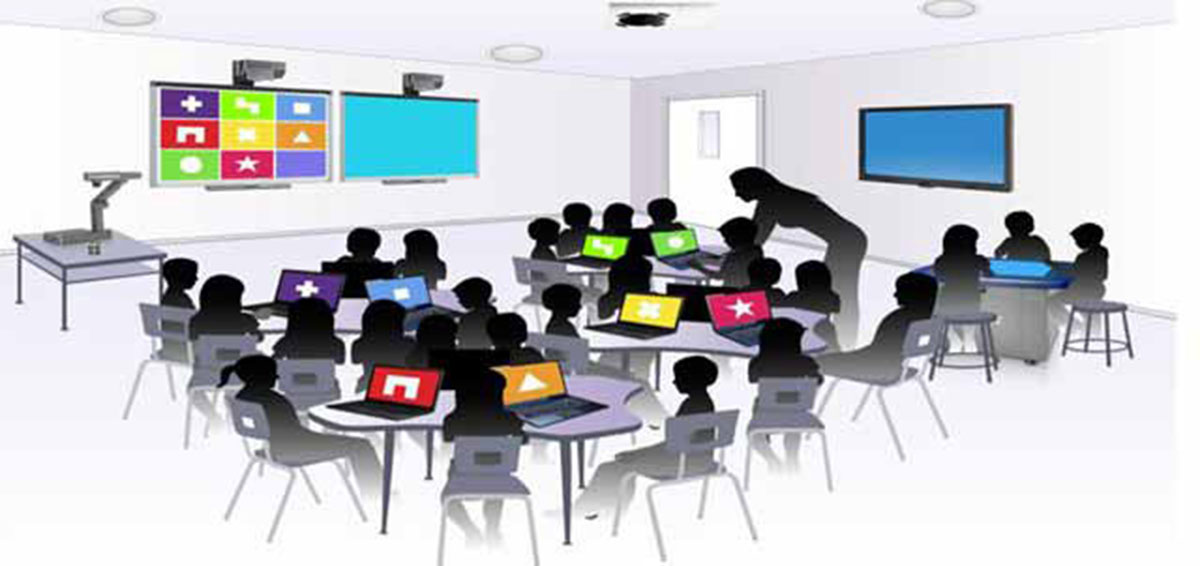by Mukhtar Ahmad Farooqi
With the emergence of the Covid-19 pandemic and subsequent lockdown to break the chain of transmission across the globe, millions of students both at elementary as well as tertiary levels have been out of their institutions. As access has been denied to the physical classrooms, the virtual spaces emerged as alternatives. Technology came to the rescue, finally.
Virtual Classroom
An alternative in the current crisis, the virtual classrooms have been of immense support. Finkelstein (2006) defines virtual classroom as a visual contact between participants (learners) and instructor in an online environment. A face to face conversation.

According to Parker and Martin (2010), virtual classrooms are online environments that enable students and instructors to communicate synchronously, using audio, video, text chat, interactive whiteboard, application sharing, instant polling, and other such features, as though they were studying face to face in a classroom.
Known as e-school, a virtual classroom is a teaching-learning environment where learners can communicate, interact, view (material), discuss and engage with learning resources in an online setting. The virtual classroom is also known as a virtual learning environment (VLE). In simple terms, the virtual classroom is an online classroom environment facilitated via specialized video conferencing apps.
The most common tools that we can use in VLE are video conferencing, instant messaging tools, and online whiteboard for real-time collaboration. There are so many mobiles as well as computer apps that can aid us in VLE like Zoom, Vedaemo, Google Hangouts (in Google Classroom), etc. rather are currently used by several educational institutions across the valley. Apart from these, Elluminate, Adobe Connect, WebEx, Wiziq, Centra are some commercially available virtual classroom software.
In a virtual classroom setting, the learners are taught through synchronous instruction which means that the teacher and the learner feel in a real-world conventional classroom system as they are logged into the classroom (rather virtual) at the same time. VLEs are considered most suitable in teaching and learning of science-based subjects. But for any type of Virtual Education use of multimedia technologies and availability high-speed internet is a must-have. The advent of virtual classes can be traced back to the mid-1990s.
Efficacy of VLEs
Despite so many benefits of VLE in normal conditions like real-time teaching and learning, effective and efficient time management, end to end communication etc., there are several impediments in its implementation at grassroots level as far as public educational institutions in India in general and Jammu and Kashmir, in particular, are concerned.
VLE demands availability of computers/mobile phones (smart) and access to the internet which might not be available to everyone. Lack of access to requisite hardware like Smartphone’s /computers due to poor economic condition is the biggest impediment as far as Public (Govt.) schools are concerned because most of the learners in these schools belong to BPL families that hardly manage to live hand to mouth and possessing a Smartphone is still a dream. Even at the college level, almost 20% of students don’t own smart gadgets especially those belonging to the rural populace. If the participation of the students is 20-30 per cent, then what objective we are going to achieve is questionable.

Let us do a case study by quoting an example from a real-life situation. Let us assume there are 15 students in a class and only parents of 4-5 students possess a smartphone who are inside their houses during mornings/evenings only, then how this initiative is going to prove fruitful as participation at the maximum is 30% in this case.
Another limitation is the bandwidth (speed) of the internet that is prerequisite to effectively deliver the content as low bandwidth internet (2G) makes the mockery of the whole initiative as low-speed internet takes hours for uploading or downloading even a few MB(sized) files.
Another impediment could be the skill set. The basic know-how is required to use the video conferencing apps like Zoom etc. as most of the students belonging to the government schools are first-generation learners. Neither they nor their parents whom these innocent children could turn to in the absence of teachers possess those skills.
Apart from the above limitation’s another the challenge for a common man is the security flaw in certain apps like Zoom that sends the user data to social networking sites without the knowledge of the user that can prove disastrous as novice users of mobile banking apps can be easily cheated by fraudsters using their data.
Conclusion
There is no doubt that the merits of VLE immensely outweigh the demerits especially in developed countries but due to lack of access to high-speed internet/ hardware (smartphones), its efficacy in public sector education set up especially at the elementary level is negligible. The main reason being the age of the target group(learners) at the elementary level where the role of the teacher is supposed to be pivotal. The only option they are left with is to turn to their parents who being illiterate and poor are unable to offer any help to them in this situation. Use of multimedia technologies like these may prove helpful at high school and above levels but at the elementary level, it will prove as causality and is debatable.
(Mukhtar Ahmad Farooqi is a freelance writer and educator. Ideas expressed are authors personal)















